-
Paper Information
- Next Paper
- Paper Submission
-
Journal Information
- About This Journal
- Editorial Board
- Current Issue
- Archive
- Author Guidelines
- Contact Us
International Journal of Arts
p-ISSN: 2168-4995 e-ISSN: 2168-5002
2018; 8(2): 30-39
doi:10.5923/j.arts.20180802.02

Aesthetic Investigation of Razavi Holy Shrine Inscriptions According to Educational & Moral Concepts (A Case Study of Dar Alhofaz (The House of Quran Keepers) Porch
Ashraf Bagheri Poor1, Hasan Bolkhari Ghehi2
1Department of Islamic Art and Humanities, Imam Reza International University, Mashhad, Iran
2Department of Fine Arts, University of Tehran, Iran
Correspondence to: Ashraf Bagheri Poor, Department of Islamic Art and Humanities, Imam Reza International University, Mashhad, Iran.
| Email: |  |
Copyright © 2018 The Author(s). Published by Scientific & Academic Publishing.
This work is licensed under the Creative Commons Attribution International License (CC BY).
http://creativecommons.org/licenses/by/4.0/

The most valuable gift which is given to human being by God is the holy Quran [1]. talented and enthusiastic artists, aiming to improve Quranic arts during prolonged centuries. defined their mission as decoration and adornment of religious places with God words and verses. The most appropriate locations for such premium art is the heavenly court of Imam Reza (p.b.u.h) the inscriptions of Razavi holy shrine have been left a great legacy to reproduce this sacred art. [1]. Such inscriptions have been investigated from various aspects by the researchers in different eras. The artists did their best to decorate the gem of divine verses, meanwhile the scholars struggled to extract educational and moral concepts of such masterpieces [2]. Because divine messages and orders have been played a major role in extending faithful society and (as an inspiring guide) to save the faithful community through human being religious thoughts history; the present study tries to discover an aesthetic relation of Quranic themes of Razavi shrine inscriptions to educational & moral concepts. Based on such goal, the methodology of this study is library and field data gathering method are used to obtain materials of the research. The study findings propose that inscriptions of Razavi shrine have two essential functions: first, to decorate and beautification of the holy shrine, then, educational & moral function.
Keywords: Aesthetic, Quranic themes, Educational & moral concepts, Aesthetic concepts, Razavi shrine inscriptions, Dar Alhofaz porch
Cite this paper: Ashraf Bagheri Poor, Hasan Bolkhari Ghehi, Aesthetic Investigation of Razavi Holy Shrine Inscriptions According to Educational & Moral Concepts (A Case Study of Dar Alhofaz (The House of Quran Keepers) Porch, International Journal of Arts, Vol. 8 No. 2, 2018, pp. 30-39. doi: 10.5923/j.arts.20180802.02.
Article Outline
1. Introduction
- Imam Reza arrival to Iran commenced a great intellectual and cultural development in mundane life structure and spiritual life of Iran people, that can be easily found in the oval-shaped domes, Arabesques painting and tile-works and inscriptions of Razavi sacred shrine [1].A glance at tile- works themes and the holy shrine inscriptions (which can be listed as the world art masterpieces) shows that the Quranic subjects are truly obvious in them (fig 1 & 2). Perhaps, one may implicitly divide the Quranic arts used in above mentioned inscriptions into external arts and conceptual arts [3]. Having in mind the explanation that such arts which directly aim to decorate and beautification of the location for the pilgrims of the holy shrine can be named as external art.
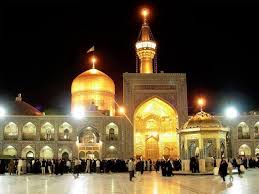 | Figure 1. Razavi shrine, mashhad, iran |
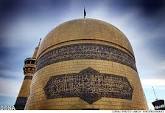 | Figure 2. Inscriptions of razavi sacred shirne |
2. Methodology
- The present study concentrates on conceptual interpretation and analytic approach to emphasis on the word meaning in different contexts and tenors. Accompanying this method, we used Quran to Quran interpretation. Moreover, we selected Quran – Quran interpretation such as Almizan” interpretations (Tabatabaee, Hamadani translation 1995). Social –jurisprudence interpretation “Nemoneh” (makarem, 1995). Social- educational interpretation “Noor” (Qaraatee. 2004), and also we used “Foladvand” translation of Quran amongst current Persian translations of Quran. More over; anywhere it is appropriate, we used other interpretations, translations or lexicons of Quran. The method of this study is as so: firstly, all the verses of inscription were gathered, then translated and interpreted according to their grammatical role, tenors, context, dignity of deliverance etc. Finally, we tried to extract basis and principals of educational and moral concepts. Because some religious philosophers consider moral speech and action as equal as beauty matter in art philosophy (1). Spiritual and aesthetic functions of Razavi shrine can be taken into account in such way.
3. Literature Review
- There are historical sources about Razavi shrine. We can mention three books about arts of the holly shrine tile-work and inscriptions which were published by art creation institute of the holly shrine. The first book, titled” art in the holy shrine, a review on arts used in Razavi shrine. written by Behzad Nemeti (2012), introduces the arts of the holy shrine generally, the second and third books are serial book of “anthology of art master pieces of the holy shrine written by Mehdi Sahragard (2013) which discuses about history and analysis of Goharshad mosque inscriptions and put forward an investigation of Enghlab court inscription (fig 3). Other sources can be named as follows: MA thesis of Sedaghat Jabari (2013) titled “ harmonious and relationship of optical elements in Razavi inscriptions / old court [sahn (the yard) Atiq]: said Mohammad Hossin Shah Mohammadi (2010) titled “Graphical investigation of tile signs of Goharshad mosque and the comparison of it with qiasiah khargard mosque: Bahareh moqadam (2013) titled “ color and sign in tile work of Safavi era of the holy shrine and the comparison of the same era tile-work in Esfahan. Rihana Al shikh, titled” investigation of tile signs of the holy shrine; and Elaheh khakshor, titled” investigating of sign and design of tile- work in Razavi shrine after Islamic revolution. All MA thesis are about art work of Razavi shrine, but in none of them, an analysis of concepts and relationship of art to educational and moral agenda was studied. This is the innovation of the present study (fig 4).
 | Figure 3. Quranic incription on the dar alhofaz porch (1) |
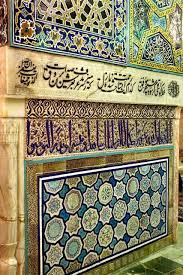 | Figure 4. Tile-work on the ravaq |
4. A Brief History of Dar Al-hofaz Ravaq (House of Quran Keepers Porch)
- Porch (Ravaq) means “threshold”, house shady place “stoa” [8]: basically it means a covered columned space which is located on sides of the court of a mosque or other religious places. The opening of such places are toward the court of a mosque and connects the mosque entrance gate to the nocturnal prayers place or dome house [9]. The porches (ravaqs) are around the court, designed for prayers. Their materials are almost the same everywhere: they are covered by marble stone. Their plinth is covered by marble till 5.lm and are covered by mirrors after that [10]. Imam Reza (p.b.u.h) shrine has many porches which the oldest ones are those of Dar Alhofaz ravaq, belonged to Timori era with 270m2. This porch is located at south of holy threshold and at the north of Goharshad mosque which was built by Goharshad Aqa at the early of 9th century (A.H). This porch as its name suggests, has been a place for Quran keepers and readers. (fig 5 & 6).
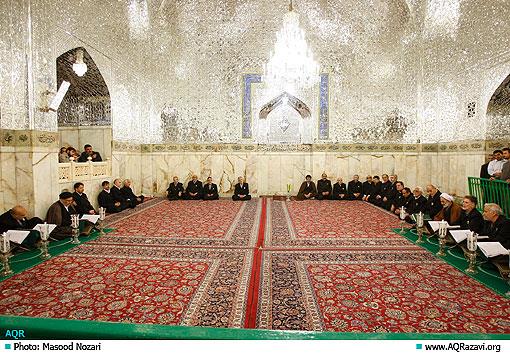 | Figure 5. Ravaq dar alhofaz (1) |
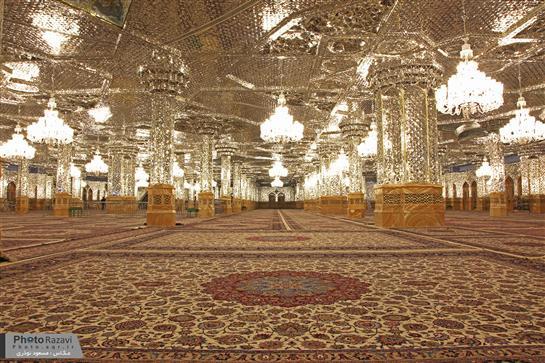 | Figure 6. Ravaq dar alhofaz (2) |
5. Investigation of Quranic Inscriptions in Dar Alhofaz Porch
- Dar Alhofaz porch has many Quranic inscriptions, Islamic narratives and Persian poems. Seventeen inscriptions have been studied for the present research which is investigated one by one. Although the context of this study is religious, we chose aesthetic approach to evaluate educational concepts such as beauty or transcendence. This study tries to put forward a practical solution to extract rich Quranic themes in the realm of educational activities. According to such approach, seeking the findings of the study is a philosophical method, including analysis way and conceptual interpretation and deduction is a practical analogy. From this point of view, we firstly analyze Quranic themes of each inscription, then we focus on the principals and education ways extracted of these themes. 5.1. O Ye Who Believe! Enter not the Dwellings of the Prophet for a Meal without Waiting for the Proper Time..., (33/53)1This verse which is known as “Entrance permission” verse, engraved at the entrance of the porch. This verse talks to the people and Muslim and the another part of the verse is about how to behave with the holy prophet (p.b.u.h) and his dynasty in short sentences [6]. Firstly, the verse says:" O Ye who believe! Enter not the dwellings of the Prophet for a meal without waiting for the proper time...". which defines the rules that have been less behaved in that part of Arab land in those days. Although the verse is talking about the prophet house, it surely does not confine to that house. It is about a general rule not to enter anybody house without his permission has said in Noor2 [24/35] (2). We even know that in the prophet tradition, he always asked for permission whenever he wanted to enter his daughter (Fatemeh) [6] (vol. 17, p.399). It is obvious that ignorance of such rule bothers the host and is not coincide with moral principal [7] (vol. 16, p.261). The messages taken from this verse represent that faith requires politeness. Rest should be considered for all in their homes. Entrance permission must be taken for everyone who wants to be a guest. The host has the right prohibited whom he doesn’t like to be his guest. It is better to take party at home. Entrance permission should be taken somehow which is not necessarily confined to verbal permission. The verb” permission is in a passive voice form that means the hosts permission may be acquired anyway [7] (vol.7, p. 392). This verse points to another significant tradition in Islam which represents that ordinary people have right to visit their official in their houses. Educational concepts extracted from this verse are as follows: “observation of others right “," humiliation “, " punctuality”, " hospitality", " reservation of torment" [12] (fig 7).
 | Figure 7. Quranic incription on the dar alhofaz porch (2) |
 | Figure 8. Quranic incription on the dar alhofaz porch (3) |
 | Figure 9. Quranic incription on the dar alhofaz porch (4) |
 | Figure 10. Quranic incription on the dar alhofaz porch (5) |
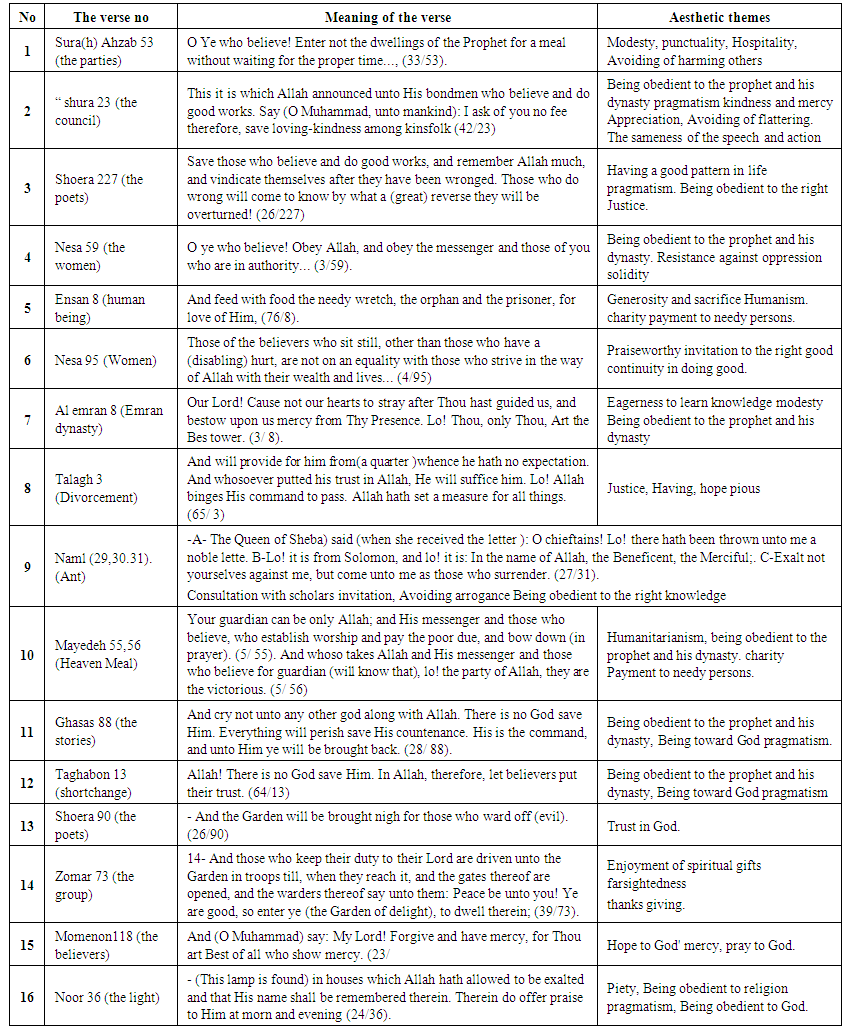 | Table 1. An index of findings of Aesthetic Analysis of the inscriptions of Dar Alhofaz porch |
6. Conclusions
- A glance of this study toward Quranic inscriptions of Dar Alhofaz porch of Razavi holy shrine and extraction of educational and moral concepts covert in the verses, will increase the value and efficiency of evaluating such art works. Pilgrims who visit Razavi shrine will enjoy such inscriptions and plus visual interest, they will think of the themes and concepts of the verse printed on the inscriptions [26]. This part of art is the spiritual art which show itself in tile- work and inscriptions. As the great scholar of Islam, Jahafari said: morality in Islam, is a part of beauty and may be called a kind of spiritual beauty or in another behavioral beauty [27]. Extraction of moral and educational aspects covert in Razavi inscriptions represents the unity of form and content in Islam art. And the artists using Quranic themes as the most obvious religious text, tries to recreate the role of art and beauty in guidance of human being toward God and finding a similarity between terrestrial art and the absolute beauty [28]. The end goal of educational purpose of Islam is modified using of current potential in Islamic art to find a mechanism to improve the soul of human being. Because in educational art function, human being is in the center of concentration. The present study propose more investigations to reveal another facets of covert educational purposes in Razavi holy shrine and other religious and sacred places to obtain a context to final spiritual education and to define implicit reasons in several educational and training organizations.
7. Footnote
- 1- In this direction, there are many evidences of using the word “beauty” instead of other synonym words in Quran. Sied Hassan nasr (khrazi, translation, 2006). in his book, “ the heart of Islam” realized that beauty and goodness in Islam are inspirable word and stressed that the word " (goodness) in translating Quran verse is an equivalency of “ beauty” in Persian (p.223). Dr Jahfari stated (198) in his famous translation of “Nahjaolbalaghe, in many cases translated this word with the word “beauty”. As an example, in translating Imam speech "the value of each person is in his eyes beauty, he wrote. The great scholar “Mohammad hosein tabatabaee also in his book” Quran in Islam” below the verse " Who made all things good which He created, translated the word as beauty (the great scholar. 2007:81).2- O ye who believe! Enter not houses other than your own without first announcing your presence and invoking peace upon the folk thereof. That is better for you, that ye may be heedful. (24/27)3- So keep your duty to Allah, and obey me. (26/110).4- Lo! Allah commanded you that ye restore deposits to their owners, and, if ye judge between mankind, that ye judge justly. Lo! comely is this which Allah admonishes you. Lo! Allah is ever Hearer, Seer. (3/58)5- Abn Abbas stated that Imam Hassan and Hossien (p.b.u.t) got sick. The holy prophet and a group of his friends visited them, they said to Imam Ali (p.b.u.h). oh, Ab Alhassan. It is better to make a vow for your children remedy: Imam Ali (p.b.u.h) and the prophet daughter and their servant Feze, Made a vow to be fast for three days for the boys to be remedied. Three days they were fast, all three days, when it was the time of breaking fast. They gave their meal to a captive, a beggar and an orphan respectively. Then God delivered this verse. 6- Ye will not attain unto piety until ye spend of that which ye love (3/92).7- He it is Who hath revealed unto thee (Muhammad) the Scripture wherein are clear revelations - - they are the substance of the Book - - and others(which are )allegorical. But those in whose hearts is doubt pursue, forsooth, that which is allegorical seeking (to cause) dissension by seeking to explain it. None known its explanation save Allah. And those who are of sound instruction say: We believe therein; the whole is from our Lord; but only men of understanding really heed. (3/7).8- ....And whosoever keep his duty to Allah, Allah will appoint a way out for him, (65/2).
Notes
- 1. All verses have been taken from Yousef Ali translation of Quran.2. the light sura(h), verse273. the poets4. The Quran interpreter who lived in the seventh century(A.H).5. According to Shia Imamas are the prophet succors which have the same authority as the holy prophet. 6. human being7. stories
 Abstract
Abstract Reference
Reference Full-Text PDF
Full-Text PDF Full-text HTML
Full-text HTML